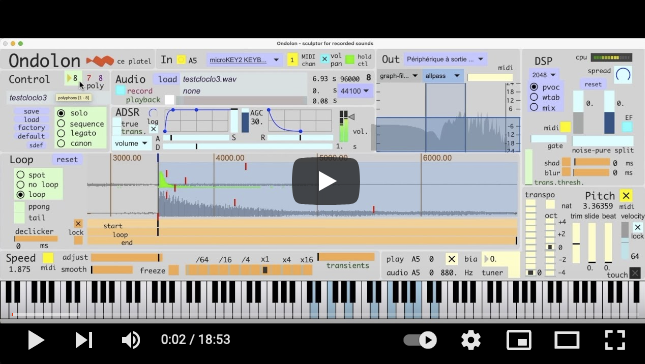Ondolon is a real-time acoustic signal processing tool for transforming natural or musical instruments sounds into invented sounds. Developed since 2011 by Charles-Edouard Platel, its concepts have since been at the source of several of his works. He now uses Ondolon as a sound sculpting tool to create works of sound sculpture to produce concrete music creations.
For example, in "Very Far Very Close", Tibetan singing boils are harmonized and orchestrated while letting their sub-harmonic resonances vibrate synchronously. At the beginning of "Forest vibes " , we can also hear baritone saxophone modulations that are multiplied in tessitura and velocity, making us hear through the magnification of reed vibrations as an accelerated perception of the biological tremors of thousands of trees. Later on, for the musical suites Migration, Vibration , Sands and Metal Flowers, most of the rhythms and sound colors result from an instrumental playing accomplished on Ondolon.
This software is a prototype, designed for experimental music . Creative Commons Attribution – No Commercial Use.
It is based upon the Max/MSP/Jitter engine, primarily designed at IRCAM and currently distributed by Cycling 74.
 The Ondolon prototype
The Ondolon prototype
Download of the Ondolon application and documentation (new version 5, needs Max/MSP/JItter from Cycling '74):
![]() version 5.00 64bits (.mxf) for MacOs and Windows
version 5.00 64bits (.mxf) for MacOs and Windows

Basic ideas
The first idea of Ondolon is to be able to exploit a sound extract in the manner of a film plan::
- detach the interesting part to exploit,
- crop in pitch and speed,
- zoom in and out to highlight the minute details of the sound,
- change its sound texture,
- still image (spot), or travel at varying speeds, including backwards.
The second idea is to allow a polyphonic playing that keeps the different voices in phase in order to respect the articulations of the sound.
The notion of instrument is essential: all settings, in a single window, can be modified in real time during the performance, according to the musician's feedback. His actions can be memorized over time so that the work session can be replayed identically. Technological artifacts are not new, but the aim is to exploit them with ease to serve an aesthetic purpose.
How does it work?
The Ondolon looks like a polyphonic sampler driven by MIDI, with specific signal processing functions:
- Digital audio playback is performed either via a wavetable derived from the audio file or via a phase vocoder.
In a traditional sampler (or tape recorder), to change the pitch of the sound (controlled by the MIDI pitch), the reading speed of the wavetable is changed proportionally. For example, to obtain a sound at the octave of the original sound, the playback speed is doubled, so the duration of the sound is halved. Thanks to the phase vocoder, speed and pitch can be defined separately: all polyphony notes remain synchronized with respect to the morphological and spectral changes characteristic of the original sound. - Sequence mode: each new note is played not by repeating the audio loop at its beginning, but after the previous note in the sequence of this loop. It is the exact unfolding of the original sound (the concrete natural melody) that takes precedence over the instrumental melodic sequence. In polyphony, the voices play this natural melody in chorus. Legato mode is similar to sequence mode, with the ADSR envelope applied to the overall sequence rather than to each individual note.
- Cannon mode: automatic triggering of new notes from a designated point in the loop.
- Transients processing : just after having loaded a new audio file, a digital pre-processing is launched to anticipate on the further real-time audio processings. Particularly the audio areas containing transients, significant of the recorded sound articulation, are detected and displayed against the mono or stereo signal waveform. This allows interesting real-time processings:
- the stationary sound areas being possibly strongly speeded down or up, the transient areas may be played with a specific speed close to natural;
- transient sounds may be accentuated or smoothed, thanks to the ADS envelope;
- the transient peaks may be accentuated using their shadows, a sort of very next echo doubling the signal.
- The AGC option allows you to raise the level of the lower audio parts.
- The spectral texture of the sound can be modified by separately adjusting the harmonic (responsible for the pitch) and anharmonic (responsible for the matter of the sound) components and reducing the residual background noise. A phase aligment of partials allows to reduce the phase shift of harmonic components. The spectral envelope of the output audio signal can be viewed and modified via a graphical equalizer.
- Conversely, the blur generator blurs spectral contrasts by a bit of random interference.
- For each played note, the hold ctl option is designed to freeze the volume and panoramic MIDI controls and the pitchbend at their values present at the note-on time, until the associated note-off, whenever these controls change on this channel.
- A tuner enables to check the fundamental frequency absolute pitch in a representative point of the original sound, so allowing to compensate its bia against the desired MIDI pitch.
- A low frequency binaural beat can be obtained by slightly shifting the frequencies of the stereo channels.
In practice
The user operates a sound recording in the manner of a video plan. When listening, he chooses a favourable zone to exploit, according to different choices of looping modes, speed, height and texture. Then it can play this zone from an external MIDI keyboard or the on-screen keyboard, while changing the previous settings with the mouse. The audio output can be routed to other software or simply recorded in an audio file.
Depending on the nature of the original sound and the settings applied, Ondolon's digital signal processing stretches or compresses the phases to provide the required result. This can produce both aesthetically stunning sound phenomena as well as unwelcome acoustic aberrations, especially in stereo. Thanks to the real-time settings, Ondolon allows you to experiment with one or more interesting game configurations.
The work is reusable:
- function to record in-water-flow audio output and user actions as they happen;
- replay of recorded user session;
- original audio files and user setting configurations can be archived in presets, for further use.
Acknowledgements
Ondolon's spectral processing is based in particular on the following research works:
Richard Dudas: GISMO: https://quod.lib.umich.edu/i/icmc/bbp2372.2002.028/1
Jean-François Charles: Phase vocoder : https://direct.mit.edu/comj/article/32/3/87/94223/A-Tutorial-on-Spectral-Sound-Processing-Using-Max
Charles E.Platel,
(August 2013, revised December 2025 for Max 9)
Turn on the sound of your computer and watch the demonstration video (18'54 ) made in 2020 for version 4:

